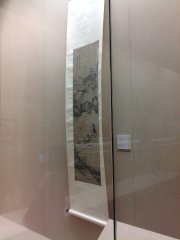
Prof. Tzay-Ming Hung discovers the mechanism for qi-wa, the curling of scrolled artwork
In the Chinese and other traditions, paintings are executed on long paper or silk scrolls. On display, those artworks may be plagued by Qi-Wa (起瓦), a curling up of the side edges that can tear fibers and dislodge pigment. Many analyses to date of Qi-Wa have focused on such factors as environmental humidity or the glue used to affix a painting to its mounting. In collaboration with the National Palace Museum in Taipei, we showed that Qi-Wa can be explained by a physical mechanism put into play when the art is rolled up for storage. Rolling compresses the inner, painted face of the scroll in the long direction and stretches the outer face. When the scroll is removed from storage, the strain relaxes. As a result of the Poisson effect, the art face gets compressed in the transverse direction, the back face is stretched, and the scroll curls along its sides. Ultimately, the amount of curling is determined by the scroll’s seeking to minimize its total stretching energy and thus is a function of various stretching moduli of the mounted artwork. Our analysis is applicable to thin sheets generally (e.g., flexible electronic paper) and suggests specific strategies for minimizing Qi-Wa. For example, we recommended aligning the fibers of the mounting paper parallel to the long direction of the artwork, a procedure contrary to the Chinese custom. (Ming-Han Chou (周明翰), Wei-Chao Shen (沈維昭), Yi-Ping Wang (汪依平), Sun-Hsin Hung (洪順興), and Tzay-Ming Hong (洪在明), “Curling edges: A problem that has plagued scrolls for millennia”, Phys. Rev. Lett. 112, 034302 (2014). Editor’s Suggestion with Synopsis in Physics. Also featured in Science, Physics Today, and New Scientist magazines.) Prof. Hong is a professor in Department of Physics, National Tsing Hua University and is a visiting researcher of NCTS.




